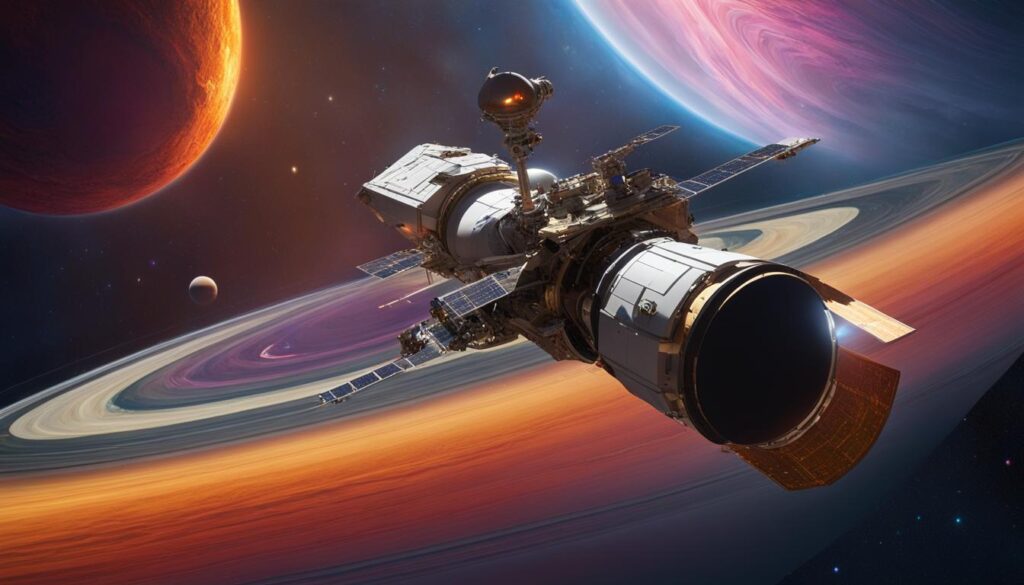Discover the breathtaking wonders of space discoveries and the remarkable mysteries of astronomy in our upcoming article. Join us on a cosmic exploration of the universe’s vastness and the intricacies of celestial wonders.
From the awe-inspiring marvels of stars and planets to the farthest reaches of deep space, our journey will uncover the latest space discoveries fueling our passion for understanding the cosmos. Embark on an adventure through the universe with us as we dive into the extraordinary realm of astronomy and its incredible space discoveries.
Stay tuned to uncover the secrets of our cosmic neighborhood and the possibility of life beyond our planet. Get ready to be amazed!
The Vast Universe and Our Place in It
The cosmos is vast and infinite, imbued with secrets and wonders that have fascinated humanity since time immemorial. Thanks to cosmic exploration and the tireless work of astronomers and scientists around the world, we continue to uncover new and incredible space discoveries that expand our understanding of the universe.
Our place in the vastness of space is both humbling and awe-inspiring. As we continue to explore the cosmos, we gain a greater appreciation for the scale and beauty of the universe that surrounds us.
From the far-off reaches of deep space to the mysteries of our own solar system, each new space discovery takes us one step closer to unravelling the secrets of the cosmos.


“The universe is a vast and wondrous place, filled with the unknown and the unexplored. But through the marvels of cosmic exploration and the determination of scientists and explorers alike, we continue to reveal the mysteries of our cosmic neighborhood.”
Unraveling the Mysteries of the Stars
Stargazing has always been powerfully captivating, whether we are lying on a blanket on a warm summer’s night or peering through high-powered telescopes. But as technology advances, so does our knowledge of the cosmos.
Thanks to astronomy and space discoveries, we can now unlock new secrets of the universe and dive deep into the world of celestial wonders.
One of the most exciting discoveries is the supernova, a massive explosion that occurs near the end of a star’s life cycle. These stellar explosions can outshine entire galaxies and produce elements that are essential to life on Earth, such as oxygen and iron.
Another mind-blowing phenomenon is the black hole. Even though black holes cannot be observed directly, scientists can detect their presence through the effects on surrounding matter. Everything that falls within a black hole’s event horizon, including light, becomes trapped, creating a region of absolute darkness.
In 2019, an awe-inspiring photograph of a black hole’s shadow was captured, bringing it into the spotlight like never before. The image of the supermassive black hole at the center of galaxy M87 was taken by the Event Horizon Telescope, a global network of radio observatories.


“The unexpected is what makes science so exciting, and we’ve certainly found unexpected things in the universe already.” – Neil deGrasse Tyson, American astrophysicist and science communicator
As we continue to unravel the mysteries of the stars, our understanding of the universe will surely expand, opening up new possibilities and avenues for exploration. Who knows what cosmic wonders we will discover next?
Planetary Exploration: Unveiling the Secrets of Our Solar System
Humanity has long been fascinated by the secrets of our solar system. As technology has improved, so too has our ability to explore the planets, moons, and other celestial bodies that make up our cosmic neighborhood.
Over the years, planetary exploration has led to an incredible array of space discoveries that have expanded our understanding of the universe. Through missions like NASA’s Voyager program and the Mars rover missions, we have gathered unprecedented amounts of data about the planets and moons that make up our solar system.


Some of the most significant space discoveries in recent years have come from the exploration of Mars. Through the use of rovers like Curiosity and Perseverance, scientists have been able to examine the planet’s geology and search for signs of past or present life.
The Search for Water on Mars
| Mission | Year | Discovery |
|---|---|---|
| Viking 1 | 1976 | The Mariner Valley, the largest canyon in the solar system. |
| Opportunity | 2004 | Evidence of past water on Mars, including mineral deposits and geological formations. |
| Phoenix | 2008 | The discovery of water ice near Mars’ north pole and the presence of perchlorate, a type of salt that could make the Martian soil habitable. |
| Curiosity | 2012 | Evidence of a past habitable environment on Mars and the presence of organic molecules. |
As the search for life beyond Earth continues, planetary exploration remains at the forefront of scientific discovery. By continuing to explore our solar system and beyond, we may one day unlock the secrets of the universe and our place within it.
Probing Deep Space: Discovering the Farthest Reaches of the Universe
Humanity has always been captivated by the unknown, wondering what lies beyond the horizon. Thanks to technological advancements, we’ve made incredible strides in cosmic exploration, with some of the most awe-inspiring space discoveries being made in the farthest reaches of deep space. From distant galaxies to the mysterious cosmic microwave background radiation, let’s take a deeper look at what we’ve discovered so far.
One of the most intriguing space discoveries in recent years was the detection of gravitational waves, revealing that space-time could ripple like a pond when massive objects move. This discovery has been groundbreaking in our understanding of the universe, shedding new light on the origins of the cosmos.
Another major discovery occurred when scientists detected the first exoplanet, a planet outside our solar system. Since then, we’ve discovered thousands more, revealing that the universe is teeming with other worlds.
“For as long as there has been a universe, there have been stars, and in those stars, generations of life looked up and wondered. It is a legacy that is written in our own DNA.”
But perhaps, the most significant space discovery, was the discovery of cosmic microwave background radiation, which is believed to be leftover radiation from the Big Bang, representing the oldest light in the universe. This discovery has fundamentally transformed cosmology, allowing us to understand the structure of the universe better.
As we continue our cosmic exploration, it’s exciting to think about the space discoveries and wonders that await us in the farthest reaches of deep space.
The Hunt for Exoplanets: Exploring Other Worlds
As astronomers continue to explore the vast expanse of space, the search for exoplanets has intensified. With the help of advanced technologies, we have been able to discover and study thousands of planets orbiting distant stars. These incredible space discoveries have expanded our understanding of the possibilities of life beyond Earth and have provided valuable insights into the formation and evolution of planetary systems.
Some of the methods used to detect exoplanets include the transit method, which involves monitoring a star’s brightness to detect a planet passing in front of it, and the radial velocity method, which detects the planet’s gravitational pull on the star it orbits. These techniques, along with others, have led to the discovery of a wide range of exoplanets, including some that are potentially habitable.
One of the most significant exoplanet discoveries to date is the TRAPPIST-1 system, which contains seven Earth-sized planets orbiting a single star. This system has been the subject of intense study, as scientists try to determine whether any of these planets could support life.


The search for exoplanets is just beginning, and with future advancements in technology, we will undoubtedly continue to make remarkable space discoveries. As we probe deeper into the universe, we may one day find worlds beyond our own that contain the ingredients necessary for life as we know it.
Conclusion
Throughout our journey exploring the wonders of space discoveries and astronomy, we have witnessed the sheer magnitude of our universe and our place within it. From the mysteries of the stars to the secrets of our solar system, we have expanded our understanding of celestial wonders beyond our wildest imagination.
Yet, there is still so much left to uncover, and the pursuit of knowledge and cosmic exploration remains an unending endeavor. The discoveries we make fuel our passion for understanding the vastness of the universe and inspire us to continue pushing the boundaries of our understanding.
As we continue to marvel at the beauty and complexity of the cosmos, we are reminded of the remarkable achievements of humanity and the limitless possibilities that lie ahead. Together, we celebrate the wonders of space discoveries, astronomy, and the celestial wonders that will continue to captivate us for generations to come.
